A new data-driven method for estimating the ages of Egyptian pyramids suggests certain pyramids may be hundreds or even thousands of years older supporting the possibility that they could have been built over pre-existing structures first established in early dynastic or possibly pre-dynastic times.
Click here to read the full paper.
Introduction
The age of certain pyramids in Egypt, particularly those in Giza, is a long-debated topic within the archaeological community. The accepted age of Khufu, around 2554 BCE, was challenged by Bauval (1989, 1993), who calculated an earlier date of 2450 BCE based on the alignment of two shafts – one to the middle star (Zeta Orionis) in the “belt” of the constellation Orion, and the other to Thuban, the former pole star. Moving the date of Khufu almost a century earlier turned out to be consistent with Spence’s revised dating of 2480±5 BCE. Spence (2000) hypothesized the Egyptians used the simultaneous transit of two circumpolar stars, Mizar and Kochab, to align the pyramids when there was no pole star.
In a recent article, Marco Vigato argues the Giza pyramids could have been existing structures that were modified and expanded by Khufu, Khafre, and Menkaure. He suggests the original structure that later became the pyramid of Khufu might have resembled Mastaba 3038, thought to have been built toward the end of the First Dynasty, circa 2900 BCE. In his survey of the Giza pyramids, Petrie (1885) states:
During the course of building there was evidently a great change in the style of the work; a change, however, belonging more to the builders than to the masons… In the King’s Chamber the masonry is very fine, both in its accuracy of fitting and in the squareness and equal height of all the blocks; but the builders were altogether wrong in their levels, and tilted the whole chamber over to one corner… It would be difficult to suppose any architect allowing such errors of building, after so closely restricting the variations of masons’ work, it strongly suggests that the granite had been prepared for the chamber long before it was built, and that the supervision was less strict as the work went on.
The change in workmanship noted by Petrie is at the level of the 35th course of masonry. It is conceivable that the courses below could have been built first as part of an earlier structure with those above added by Khufu. In this way, the original pyramid could be older and still satisfy Bauval’s star/shaft alignments.
The possibility that the pyramids could be at least a few centuries older is supported both by radiocarbon and optically stimulated luminescence (OSL) dating. Radiocarbon dates of wood found within Khufu and Khafre are several hundred years older than the pyramids’ accepted ages. Although neither Khufu nor Khafre has been OSL dated, Liritzis and Vafiadou (2014) found Menkaure’s granite casing could be as much as a millennium older. Samples from other structures on the Giza necropolis also indicate earlier dates.
A New Method of Dating
Instead of assuming the alignments are necessarily astronomical in nature, analysis of other properties of pyramids offers new clues that may have been overlooked. We start with a table of measurements for ten 3rd-5th Dynasty pyramids.
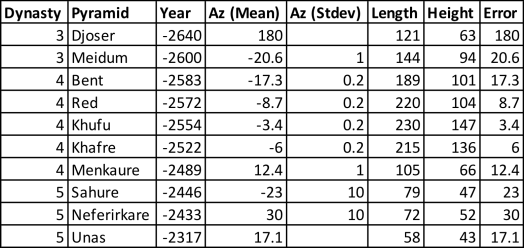
Where most are confident of the ages of more recent pyramids, some are unsure about others. Data science methods offer a way to use what we know to estimate what we do not know.
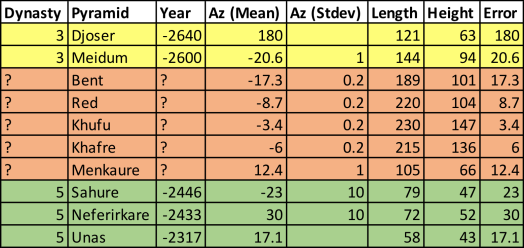
In mathematical terms, if we treat the pyramid measurements in the above table as independent variables x and age as a dependent variable y, then the problem can be formulated as determining a function f for estimating the age of a pyramid from its measurements
y’ = f(x)
Correlations exist between variables over different periods of time. For example, the graph below plots the alignment error (deviation from true north) vs. base length. These two variables are negatively correlated, indicating that larger pyramids tend to be better aligned than smaller pyramids.
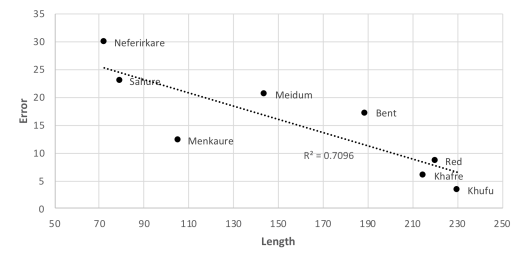
By analyzing these correlations, a technique known as linear regression can be used to compute functions for estimating the age of a pyramid from its measurements. Using the accepted years of construction and lengths of Sahure’s and Neferirkare’s bases, we can estimate the year of construction of the other pyramids from their base length according to the linear equation:
t’ = – 2299 – 1.85 b
which is plotted below.
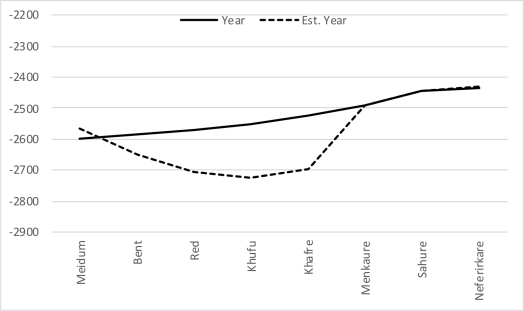
Notice the estimate of Menkaure matches its accepted date almost exactly. For earlier pyramids up to Meidum, the estimated ages are older than the accepted ages. According to this estimate, Khufu would be 170 years older than its currently accepted age.
Other estimators can be constructed using different measurements. Perhaps the most interesting result is based on using a pyramid’s precision and volume (discussed later in this article) to estimate its age, which is plotted below.
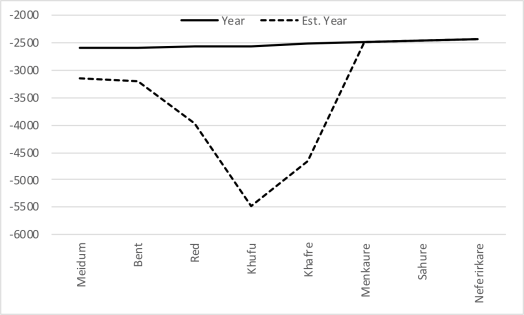
The figure below summarizes the results of six estimators plotting the average estimated ages of the pyramids along with error bars indicating their ranges. Based on these estimates, certain late 3rd and 4th Dynasty pyramids could be thousands of years older.

Evidence of Technological Decline
Any theory attempting to estimate the ages of the Giza pyramids must also explain their size and precision. An order of magnitude increase in the volume of the 4th Dynasty pyramids over those in earlier and later dynasties is an anomaly that has yet to be explained by mainstream Egyptology. Similarly, there has been no attempt to explain the increase in precision in the 3rd and 4th Dynasties, followed by a marked decrease in the 5th Dynasty. Precision is a measure of workmanship. Why did it improve only to decline in only a century?
The ability to precisely align the parts of a structure is indicative of a high level of technology. Although the standard deviation is often used to measure the tolerance of an assemblage, it does not characterize the level of difficulty involved. For example, if we assume that is it twice as hard to align structures to a tolerance of ±½ inch as it is to a tolerance of ±1 inch, the inverse of the standard deviation (1/σ) is a better measure of the precision and the level of difficulty required to achieve it.
The ability to build large structures is also an indicator of advanced technology. Another measurement not yet considered is the height of a pyramid. But instead of using just the height or base length, consider the volume v, which depends both on base length and height. The product of volume times precision provides a single number, a technology index, L = v/σ that can be used to characterize the level of technology involved in building a pyramid. The following graph plots the technology index vs. the accepted year of construction L(t).

How does one explain a century-long technological anomaly in an early Bronze Age culture? If we assume these pyramids are older, changing the order, the anomaly becomes a decline. The graph below plots the technology index vs. estimated year of construction L(t’).

The four trendlines in the above figure are based on different datings. The mean trend is the average of the six age estimates. The min/max trends are one standard deviation above and below the mean. The trend marked “same” plots the ages computed from the estimator that uses volume and precision. All of these trendlines are highly correlated with the estimated ages. A decreasing technology index suggests pyramids thought to be late 4th/early 5thDynasty could have been built during an earlier period of technological decline.
Although a great deal of uncertainty remains over their exact ages, it is possible the Bent, Red, Khafre, and Khufu pyramids were either built much earlier or were built over pre-existing structures. That these pyramids may pre-date the dynastic period suggests they were not built by the Egyptians but by their predecessors.
References
M. Flinders Petrie (1885) The Pyramids and Temples of Gizeh, Second Edition, Published by Histories & Mysteries of Man Ltd., London, 1990.
Robert G. Bauval (1989) “A Master-Plan for the Three Pyramids of Giza Based on the Configuration of the Three Stars of the Belt of Orion,” Discussions in Egyptology, ISSN 0266-3083.
Robert G. Bauval (1993) “Cheops’s Pyramid: A New Dating Using the Latest Astronomical Data,” ibid.
Kate Spence (2000) “Ancient Egyptian chronology and the astronomical orientation of pyramids,” Nature, Vol. 408.
Ioannis Liritzis and Asimina Vafiadou (2014) “Surface Luminescence dating of some Egyptian Monuments,” Journal of Cultural Heritage.


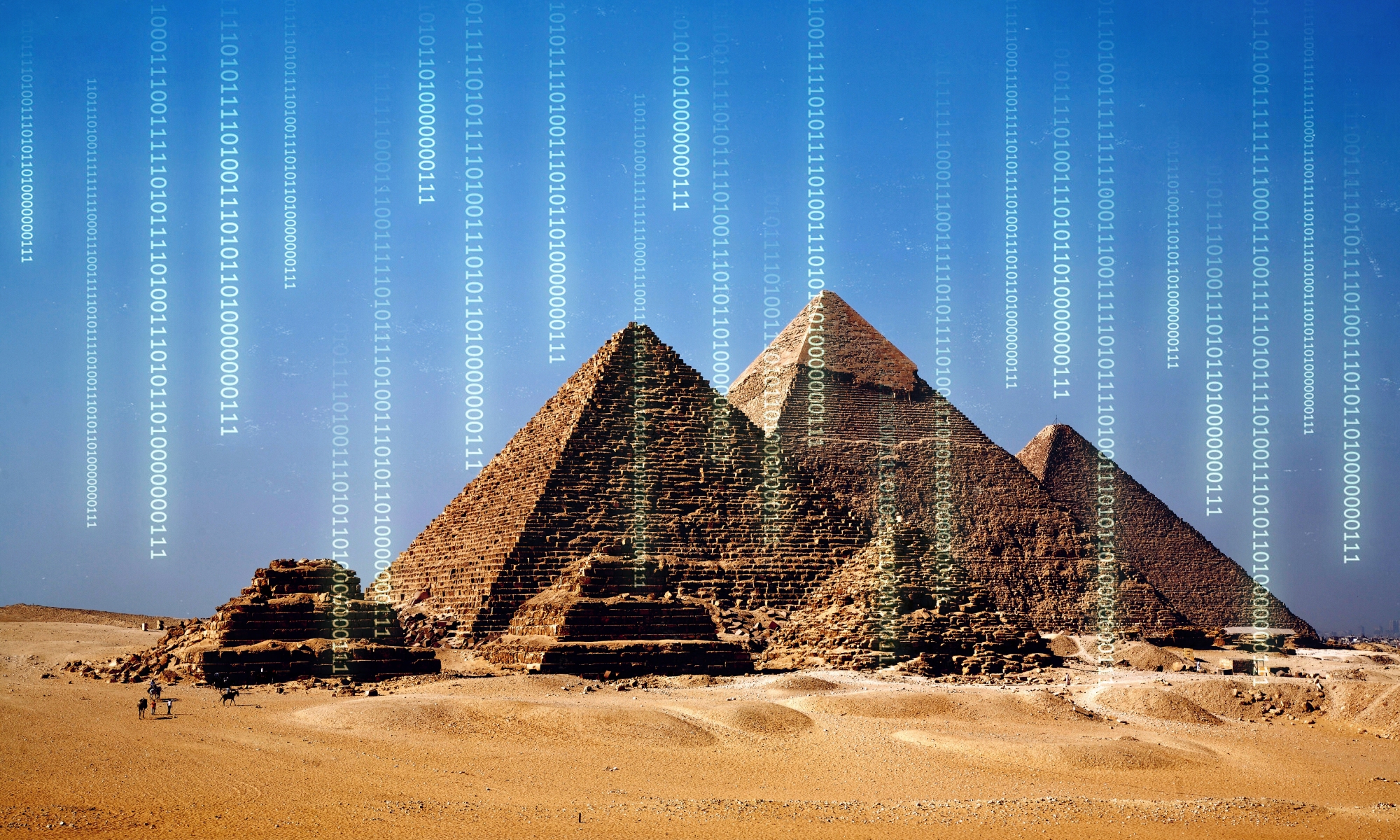

2 Replies to “Data-Driven Pyramidology: From Pseudoscience to Data Science”